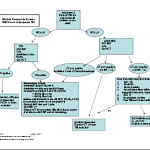The number of elderly patients needing care at trauma centers is skyrocketing. Many are on anticoagulants for medical conditions, most commonly atrial fibrillation. When one of these patients is seriously injured, anticoagulation can cause serious and life-threatening complications that might otherwise not occur.
Reflexively, many trauma professionals decide to just stop the medication, especially if they believe that the patient may injure themselves again (and again, sometimes). However, this may not always be a good idea. Remember the good old juice to squeeze ratio. Look a the risks (reinjury) vs the potential benefits (stroke prevention). The easiest way to assess this is to use CHADS2.
CHADS2 is a validated scoring system for predicting stroke risk in people with atrial fibrillation. There are 5 components as follows:
- C – congestive heart failure – 1 point
- H – hypertension (treated or untreated) – 1 point
- A – age >= 75 – 1 point
- D – diabetes mellitus – 1 point
- S2 – history of stroke or TIA – 2 points
Stroke risk is directly correlated to the number of points scored. So based on that the recommendations are:
- Score = 0: low risk, no therapy needed or just take aspirin
- Score = 1: moderate risk, aspirin or oral anticoagulant
- Score >= 2: moderate to high risk, take oral anticoagulant
Bottom line: Evaluate every trauma patient on anticoagulation to see if they really need to keep taking it. If it’s for a one-time episode of DVT or PE that happened years ago, they should be able to stop. If it’s for a-fib, check their CHADS2 score and work with their primary care provider to see if they could take aspirin or nothing. Factor in a history of frequent falls or car crashes as well.
Related posts:
Reference: Selecting patients with atrial fibrillation for anticoagulation: stroke risk stratification in patients taking aspirin. Circulation 110 (16): 2287–92, 2004.

